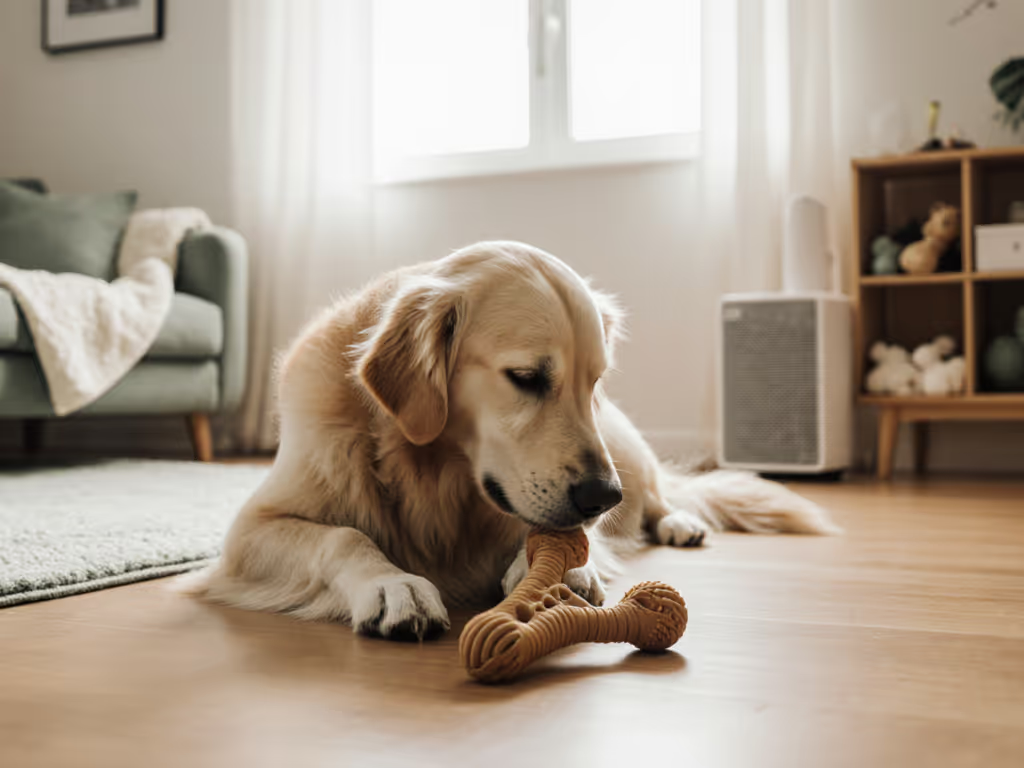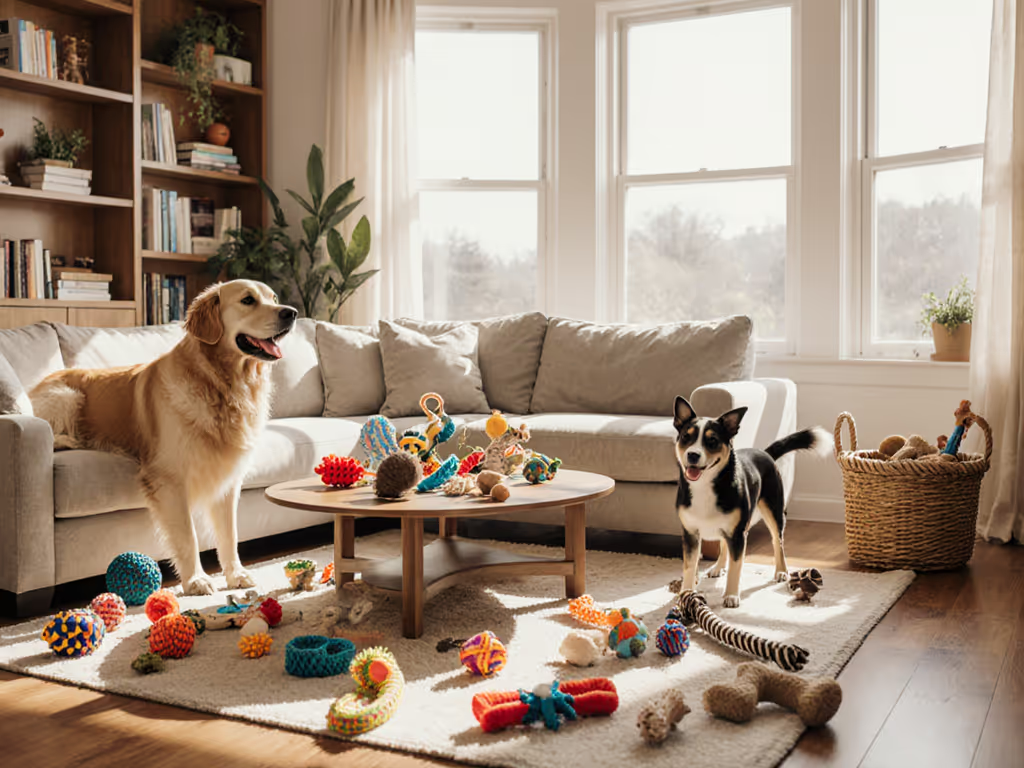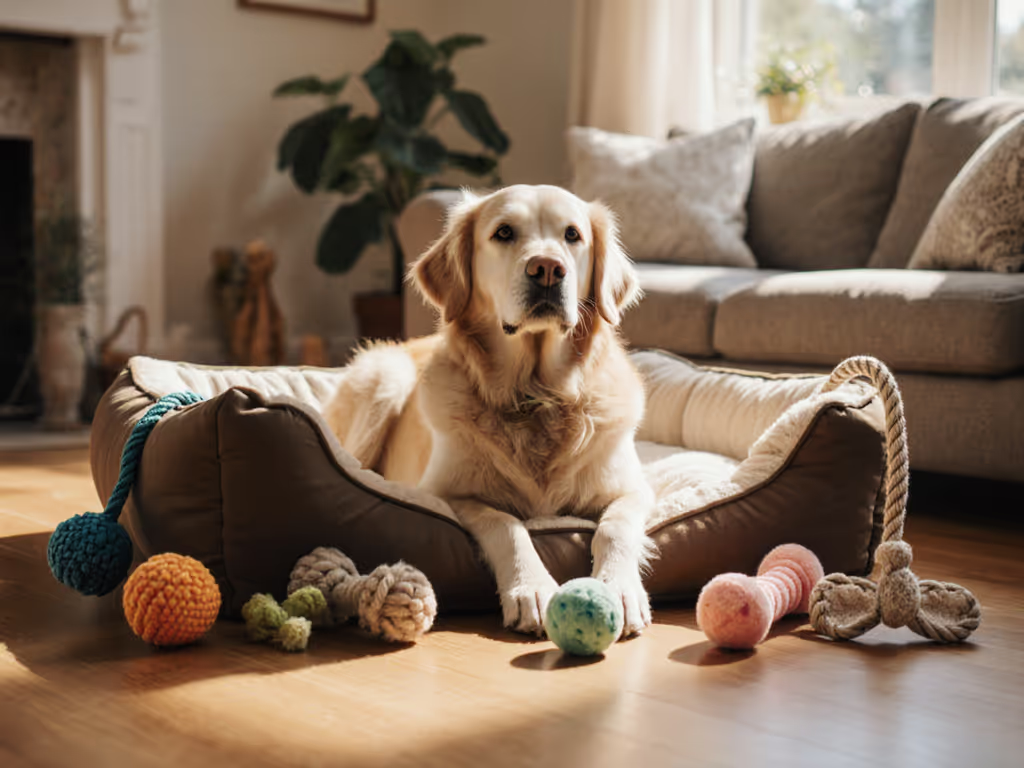
Match Best Dog Toys to Age: Safe Durable Choices Guide

Choosing the best dog toys means more than matching jaw strength to durability claims. It is about aligning play with your home's reality. Too many guardians invest in flashy toys only to face shattered rubber, deafening squeakers, or stuffing explosions that disrupt WFH hours. The best dog toys balance developmental needs with apartment-friendly noise profiles, cleanable surfaces, and supervision demands that fit real life. Quiet brains beat loud rooms: design enrichment around life.
Having tuned hundreds of enrichment plans for foster dogs in shared-wall apartments and multi-dog households, I've seen how mismatched toys escalate stress instead of easing it. When a power-chewer shreds a plush toy during your Zoom call, or a bouncy ball wakes a night-shift neighbor, play stops being enrichment and starts feeling like a chore. Let's reframe toy selection through what actually matters in constrained homes: noise, mess, supervision load, and cleanability across your dog's life stages.
Why Age-Appropriate Toys Must Fit Your Home Constraints
Dogs' play needs evolve through developmental stages, but conventional advice rarely addresses how those needs intersect with urban living. A toy safe for teething isn't helpful if its squeaker triggers neighbor complaints at 2 a.m. Durable adult chew toys become hazards if they shed microplastics across hardwood floors. The gap is not in toy quality. It is in evaluating toys through a household lens.
During my foster work with a herding breed in a thin-walled complex, I measured decibel spikes during 2 a.m. zoomies. The lesson? Durability means nothing if noise profile disrupts sleep cycles. Now I rate every toy through four filters:
- Noise profile: Decibel range during active chewing/play
- Mess index: Propensity for crumb trails, stuffing leaks, or sticky residues
- Supervision load: Time you can safely leave the toy unattended
- Wash cycles: Dishwasher-safe clarity and material resilience
These metrics transform guesswork into repeatable systems. Let's apply them to each life stage.
Puppies: Teething Toys That Respect Quiet Hours
Puppies need teething toys that guardians can trust during fragile nap schedules. But soft rubber alone is not enough. We must consider when and where chewing happens. In apartments, high-pitched squeakers (85+ dB) risk neighbor conflicts, while plush toys with loose stuffing create vacuum-worthy mess indexes.
Prioritize toys with noise profiles under 65 dB (comparable to normal conversation) and zero stuffing. Frozen knotted ropes soothe gums quietly, while solid rubber chews like the KONG Puppy avoid splintering hazards. Always verify material safety: no BPA or phthalates that could leach during teething.
Actionable framework:
- Supervision load: medium for frozen ropes (monitor for rope-chewing habits)
- Supervision load: low for solid rubber (safe for 15-minute unattended chewing)
- Mess index: Rate stuffing-free options as 1/10 vs. plush toys (7/10)
- Wash cycles: Dishwasher-safe toys withstand 50+ hot cycles

KONG Puppy Teething Rubber Chew Toy
Adults: Power Chewers Without Power Struggles
Adult dogs demand durability, but "indestructible" claims often ignore home realities. High-drive breeds need mental engagement that doesn't sacrifice peace. A hard rubber toy may survive chewing, but if it bounces erratically across tile (noise profile 75+ dB), it's counterproductive for WFH households.
Focus instead on predictable failure modes and cleanability. Does the toy flake gradually (safe retirement cue) or shatter into shards? Are crevices smooth enough for one-swipe wipe downs? I time chew sessions to note when frustration spikes (usually when treats get stuck in inaccessible pockets), escalating noise and mess.
Critical metrics:
- Noise profile: <70 dB for shared living (tested with free decibel apps)
- Mess index: Treat-dispensers rate 3/10 if they release kibble cleanly
- Setup time: Under 2 minutes for busy households
- Wash cycles: Seamless designs last 3x longer in dishwashers
Supervision load: low for solid treat balls, medium for puzzle feeders requiring reset
Seniors: Gentle Play That Supports Dignity
Senior dog gentle play requires rethinking "softness." Many plush toys marketed for seniors unravel into choking hazards within hours, creating dangerous mess indexes. Instead, seek materials that cushion joints without compromising safety (like closed-cell foams that won't shred when gnawed gently).
For dogs with arthritis, avoid toys requiring forceful batting. Opt for low-impact scent mats where dogs can earn rewards through sniffing alone (noise profile 50 dB). Crucially, verify dishwasher compatibility, since older dogs may have accidents, and hand-washing delicate toys becomes burdensome.

KONG Senior Dog Toy
Home-harmony checklist:
- Noise profile: Under 60 dB (quieter than refrigerator hum)
- Mess index: 0/10 for non-stuffing options
- Supervision load: high for any plush (always supervise seniors)
- Wash cycles: Minimum 20 cycles for daily-use items
Building Your Home-Adapted Toy System
Matching pet dog toys to developmental stages works only when filtered through your household's constraints. Start by auditing your space:
- Measure your baseline noise: Use a free app to record ambient sound in decibels during quiet hours
- Map high-risk zones: Identify where stuffing crumbs or rubber shards would create cleanup nightmares
- Time your availability: Note how many minutes you can safely leave toys unattended
Then apply my Developmental + Household Scorecard:
| Stage | Top Toy Type | Noise Risk | Mess Risk | Supervision Load |
|---|---|---|---|---|
| Puppy | Solid rubber | Low | Low | Low |
| Adult | Treat-dispensing ball | Medium | Low | Medium |
| Senior | Scent mat | Very Low | Very Low | High |
Rotate toys weekly based on your energy levels. On high-stress days, choose supervision load: low options like frozen KONGs. During video calls, switch to silent snuffle mats. Retirement cues matter too, retire toys when rubber develops a chalky texture or seams separate, before they fragment.
The best enrichment isn't about maximum stimulation, it is about sustainable harmony. When toys align with your home's rhythm, you'll see calmer post-play settles, fewer "I have to pick up stuffing again" moments, and guardians who actually enjoy playtime. Start small: replace one high-noise toy this week with a solid rubber option. Watch how quiet brains transform your shared space.



